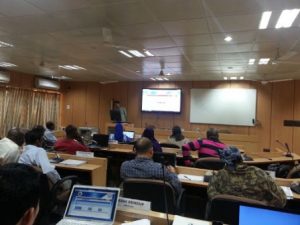Higher Education in India: Will Technology Play a Boon or Bane?
The COVID-19 pandemic has raised an array of technological issues among students in higher education, which has created hurdles for onlineeducational accessibility in India.
There is an old saying, “necessity is the mother of innovation”. Crisis brings new necessities. Therefore, crisis and innovation are related.The unforeseen closure of academic institutions due to the  COVID-19 has adversely affected the Indian educational system, specifically students and research scholars. One of the immediate measures to avoid delay in curriculum completion was the shift from classroom-based face to face learning to remote learning mode. These remote- learning, which requires significant arrangements of advanced internet-based technological facilities, raised dilemmas among students. Due to the over-dependence on internet communication networks, education is not supposed to go well with many students. A significant number of students and research scholars belong to remote areas in the country. Access to technology and determination to follow remote education are two significant challenges of continuing education for students of higher education in the country. There is an array of issues related to technologydriven education with students, which are deep-rooted with the socio-economic background of students and infrastructural barriers to education in the country.
COVID-19 has adversely affected the Indian educational system, specifically students and research scholars. One of the immediate measures to avoid delay in curriculum completion was the shift from classroom-based face to face learning to remote learning mode. These remote- learning, which requires significant arrangements of advanced internet-based technological facilities, raised dilemmas among students. Due to the over-dependence on internet communication networks, education is not supposed to go well with many students. A significant number of students and research scholars belong to remote areas in the country. Access to technology and determination to follow remote education are two significant challenges of continuing education for students of higher education in the country. There is an array of issues related to technologydriven education with students, which are deep-rooted with the socio-economic background of students and infrastructural barriers to education in the country.
Inclusive Learning
The adversities brought by COVID-19 posed a major challenge for the education system. However, with the availability of minimum technological arrangements, institutions were able to meet the immediate constraints. One of the major preparations can be seen with the ongoing ‘Digital India Mission’ of the Government of India. The government has been taking several initiatives and introducing schemes to address students’ issues and challenges. In the wake of the pandemic, the state and institutional agencies started easing services such as helpline portals to connect with the needy and helpless students. Under such critical circumstances, online help portals offered an academic support system through virtual study material and resources. Despite this, students from remote areas have not been able to integrate with the online education facilities. As reported by many news organisations, many students have been facing issues either with the technical glitches or do not able to afford digital devices. Lack of affordability of technology (such as low household income), lack of access to digital facilities (for instance, poor internet/Wi-Fi connection), technologically unfriendly behaviour (technical glitches), and lack of access to internet facilities due to rural settlementare some of the major challenges for adequate knowledge dissemination in the current scenario.
Digital devices are the foremost requirement for remote learning education. In the current context, smartphones, computer and laptops are popular digital devices for accessing remote education. According to the Statista Research Department (2020), there are 401.74 million smartphone users in India.
This number reflects that in the country, only one out of three households are in possession of smartphones. In addition to this, there are several Gram Panchayats which do not have internet facilities, broadband connectivity, and hotspot networks in the country.
Also Read : Online Education during COVID-19: Dividing the Divided
According to the latest statistics, there are 109,000 number of Gram Panchayats with the Bharat Broadband Network Limited (BBNL) as of November 2018 (Ministry of Information and Broadcasting). Considering India currently has about 250,000 Gram Panchayats, just four out of 10 Gram Panchayats have internet connectivity. The submission of assignments, student – teacher interactions, raising queries and doubts by students regarding the academic schedule, coursework and group assignments have become time-taking, ambiguous and complex process through an online medium.
Affordability
Unemployment due tothe pandemic and other social constraints pose a great challenge to the affordability of smartphones, tablets and computers. Further, availability of the smartphone does not always assure the access of device to students, since in most of the cases complete family relies on one phone and in the current crisis, students, as well as working members, havea huge reliance on the smartphone. Many students do not have smartphones or laptops to attend online classes due to the financial crisis in the family. There are families who have only one mobile phone for consumption and students have also become dependable on it for their online studies. Also, the online participation of female students has become challenging in higher education. Due to household chores and other domestic responsibilities, female students are not able to attend online classes regularly. Even in the rural areas, females have been facing difficulties in accessing digital devices and technological support.In addition to this, there are other issues due to technical glitches such as non-availability of science laboratory and chemistry experiments remotely, which resulted in a temporary cessation of the practical tests by faculty members (PTI, 10 April 2020). Therefore, the remote mode of transmitting knowledge has left students in chaos and confusion. Further, the medium of communication through information technology is still urban, and many of the sub-urban and remote colleges may not have any students with access to these technologies. Therefore, the technological dependency for learning is significantly exclusive and falsify the broad objective of mass learning.
 Students are worried about their annual academic performance, grades, teachers’ feedback on coursework and the long-term consequences of this shut down on their studies. Research fellowship and student scholarships have been suspended or postponed due to administrative delay in lockdown. Moreover, MPhil/PhD scholars who have submitted their dissertations/theses to their institutions are worrying for their viva voce examinations as well as timely reimbursement of scholarship. There are two possibilities for them in the initial months, either to get it done through online mode or to postpone it for a later stage (Gautam and Sharma, 2020). In addition to this, students have no official information or guidelines about their monthly scholarship/fellowship by the University Grants Commission.
Students are worried about their annual academic performance, grades, teachers’ feedback on coursework and the long-term consequences of this shut down on their studies. Research fellowship and student scholarships have been suspended or postponed due to administrative delay in lockdown. Moreover, MPhil/PhD scholars who have submitted their dissertations/theses to their institutions are worrying for their viva voce examinations as well as timely reimbursement of scholarship. There are two possibilities for them in the initial months, either to get it done through online mode or to postpone it for a later stage (Gautam and Sharma, 2020). In addition to this, students have no official information or guidelines about their monthly scholarship/fellowship by the University Grants Commission.
There are cases of a few students who failed to contact their institution to ask about the status of their scholarship/fellowship.
Also Read : Prisoners’ Education in India: An Institutionalised Insufficiency
The absence of administrative officials responsible for day to day functioning in universities has disconnected students from their institutions, which has, therefore, led to increased anxiety and worry among students for many academic inquiry and scholarship amount.
Policy and Pedagogical Challenges
The government has been taking several initiatives and introducing schemes to facilitate education through digital mode. The Ministry of Human Resources Development (MHRD), State and institutional agencies have been facilitating services such as helpline portals to connect with the needy and helpless students to address the issues and challenges (PTI, 2020). The government is trying to minimise educational challenges and maximise the digital benefits in this pandemic situation. Despite such measures, students’ have not been able to engage with uninterrupted online classes, clarity on evaluation or examinations as well as admission procedure for next semester. Therefore, digital education has left students and research scholars in chaos and confusion. Such issues and problems are pertinent, sensitive and challenging for resolving by the higher education institutions, state agencies and the government. A robust and transparent policy framework needs to be developed, addressing difficulties of students from poor and marginalised communities.
In the context of higher education, students have been dealing with many arrays of difficulties and challenges. The online mode of learning ishighly technological and needs an adequate level of familiarity with the communication process. Also, the education system has to adjust itself to the new reality, which is pro-technology, digital and virtual in nature. Considering the fact that the significant number of households and villages in the country do not have access to smartphones and broadband, the interim remote learning-based lockdown measure is not feasible for many students. In this context, it can be said that many students in the country will not be able to manage with online education in the current pandemic context. The government should initiate a comprehensive policy for digital higher education with particular reference to the pandemic. A need-based analysis is required for digital higher education in view of physical location, gender, technology, and socio-economic gaps. The decentralisation of digital facilities can ease the situation with the collaboration of several stakeholders.
